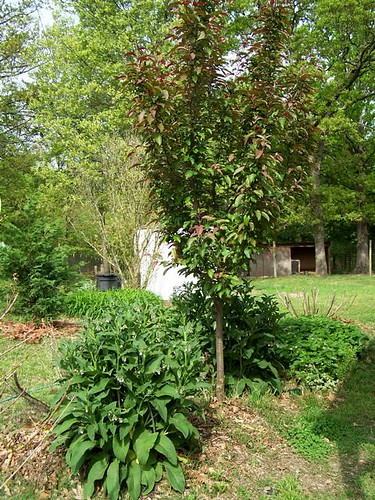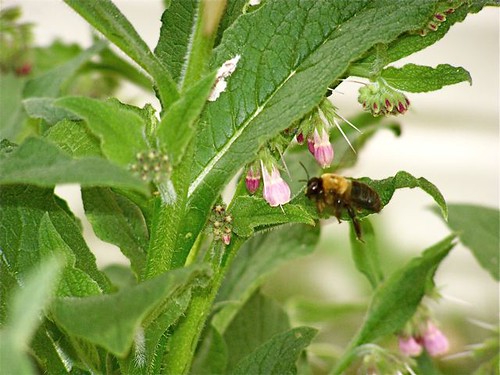
One thing I've learned from my baby-steps study of permaculture concepts is the idea of planting "guilds." That is, grouping plants that benefit each other by being in proximity. A classic example seems to be grouping a tree with smaller plants such as nutrient accumulators/mulch producers like comfrey, then some plants that attract beneficial insects etc. So last year I planted this comfrey at the base of the Prarie Fire Crabapple, a tree I treasure for the spring blooms, but mostly for it's bird-food value. (Permaculture is much more oriented toward people-feeding trees, but I'm getting to those this year...) It also has some Sedum (attracts beneficials) at its base.
And by golly, both the tree and the comfrey look remarkably happy! Comfrey is one of those great multi-functional plants that accumulates nutrients from deep in the soil, is self-mulching and weed suppressing and pollinators LOVE it. (And of course it's medicinal.) Just don't let comfrey loose in rich garden soil, or you'll soon have a comfrey farm...
The bumble bees are busy adoring every pink bloom on the comfrey. There are loads of bees this spring (bumblebees -- but I'm seeing very very few wild honeybees) and they are loving the comfrey!
Bees are hard to photograph. They are, after all, very busy.
And very beautiful in their yellow and black velvet coats.
And he's off to another flower!
So, after this experience, I'm putting a start of comfrey at the base of every new tree I plant. (Don't worry, not even comfrey can become invasive in our natural clay/gravel...) I'll let you know how it goes.
1 comment:
Wonderful post, I adore bees. Did you know that there is a parasite that is killing the honeybee world wide. The only country that does not have this problem is Australia. I have no honeybees in the garden so far this year. Treasure all bees.
Post a Comment